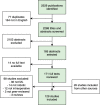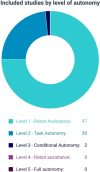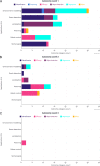Intraoperative Applications of Artificial Intelligence in Robotic Surgery: A Scoping Review of Current Development Stages and Levels of Autonomy
- PMID: 36177855
- PMCID: PMC10631501
- DOI: 10.1097/SLA.0000000000005700
Intraoperative Applications of Artificial Intelligence in Robotic Surgery: A Scoping Review of Current Development Stages and Levels of Autonomy
Abstract
Objective: A scoping review of the literature was conducted to identify intraoperative artificial intelligence (AI) applications for robotic surgery under development and categorize them by (1) purpose of the applications, (2) level of autonomy, (3) stage of development, and (4) type of measured outcome.
Background: In robotic surgery, AI-based applications have the potential to disrupt a field so far based on a master-slave paradigm. However, there is no available overview about this technology's current stage of development and level of autonomy.
Methods: MEDLINE and EMBASE were searched between January 1, 2010 and May 21, 2022. Abstract screening, full-text review, and data extraction were performed independently by 2 reviewers. The level of autonomy was defined according to the Yang and colleagues' classification and stage of development according to the Idea, Development, Evaluation, Assessment, and Long-term follow-up framework.
Results: One hundred twenty-nine studies were included in the review. Ninety-seven studies (75%) described applications providing Robot Assistance (autonomy level 1), 30 studies (23%) application enabling Task Autonomy (autonomy level 2), and 2 studies (2%) application achieving Conditional autonomy (autonomy level 3). All studies were at Idea, Development, Evaluation, Assessment, and Long-term follow-up stage 0 and no clinical investigations on humans were found. One hundred sixteen (90%) conducted in silico or ex vivo experiments on inorganic material, 9 (7%) ex vivo experiments on organic material, and 4 (3%) performed in vivo experiments in porcine models.
Conclusions: Clinical evaluation of intraoperative AI applications for robotic surgery is still in its infancy and most applications have a low level of autonomy. With increasing levels of autonomy, the evaluation focus seems to shift from AI-specific metrics to process outcomes, although common standards are needed to allow comparison between systems.
Copyright © 2022 The Author(s). Published by Wolters Kluwer Health, Inc.
Conflict of interest statement
The authors report no conflicts of interest.
Figures




References
-
- Kwoh YS, Hou J, Jonckheere EA, et al. . A robot with improved absolute positioning accuracy for CT guided stereotactic brain surgery. IEEE Trans Biomed Eng. 1988;35:153–160. - PubMed
-
- Panesar S, Cagle Y, Chander D, et al. . Artificial intelligence and the future of surgical robotics. Ann Surg. 2019;270:223–226. - PubMed
-
- Zhou X-Y, Guo Y, Shen M, et al. . Application of artificial intelligence in surgery. Front Med. 2020;14:417–430. - PubMed
-
- Kassahun Y, Yu B, Tibebu A, et al. . Surgical robotics beyond enhanced dexterity instrumentation: a survey of machine learning techniques and their role in intelligent and autonomous surgical actions. Int J Comput Assist Radiol Surg. 2016;11:553–568. - PubMed
Publication types
MeSH terms
Grants and funding
LinkOut - more resources
Full Text Sources

